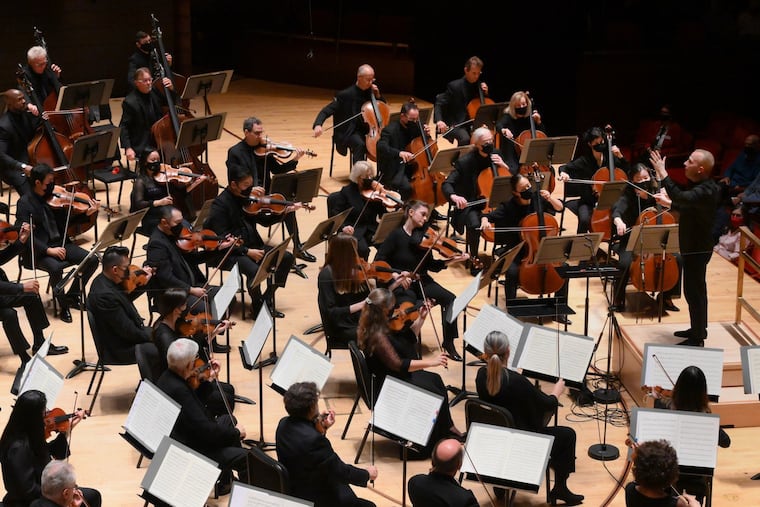Philadelphia Orchestra mixes and matches Beethoven with world premiere in response to California wildfires
Soprano Pretty Yende also made her Philadelphia Orchestra debut in a set of four Strauss songs.

Can music change the world? That’s the proposition, at least to some extent, baked into a lot of the Philadelphia Orchestra’s programming these days. In its big premieres downtown of new works, as well as through chamber music visits to neighborhood groups working with marginalized communities, the orchestra’s bubble has become permeable. The world’s concerns are theirs, the new mission seems to say, and they are here to help.
Whether or not you believe this particular orchestral superpower actually exists, the impulse to acknowledge the outside world is producing some wonderful new scores. With Friday afternoon’s premiere of Robin Holcomb’s Paradise in Verizon Hall, the orchestra took on wildfires and, by extension, climate change. The 10-minute work’s title comes from the California town destroyed by the 2018 Camp Fire, and Holcomb smartly avoids some major pitfalls.
For one, she does not preach. The music isn’t a programmatic depiction, though there are a few literal gestures in the score — some sonic sparks and a haunting bird call near the end.
For another, the piece, commissioned by the orchestra, avoids portraying destruction in any heavy-handed way. There’s a marvelously counterintuitive coldness to much of the opening mood, an eerie incandescence, as well as some Stravinsky-esque menace. Trumpet notes suggest a landscape of wide horizons. In a way, the score speaks most directly of the emotional and spiritual wreckage we are heaping upon ourselves.
Holcomb’s shifting language ultimately lands on hope. The Americana sound toward the end might be heard as a hymn to the common good, a path toward healing from climate change. Maybe it’s not too late?
Of course, the outside world has long seeped into the concert hall and the composer’s consciousness, as this weekend’s programming suggested. The orchestra now regularly offers a mix-and-match approach within a single run of programs, so while Friday afternoon’s concert matched the Holcomb with Beethoven’s Symphony No. 6 — and its more idealized snapshots of nature — Saturday night’s swapped in the composer’s Symphony No. 4.
The Fourth is a relative rarity, probably the least performed of Beethoven’s symphonies, and yet its spare, crystalline sound is unique — the lonely foreboding of the Haydn-like opening, the way the entire orchestra drops out except for a strand of connected single-instrument solos at the end of the second movement. Beethoven, so often associated with great might, seems to be exploring the power of a few well-chosen voices to fill the concert hall.
Nearly everyone is exposed in the piece. Which is why once again the reemergence of our resident orchestra in live concerts seemed so miraculous. Would Don S. Liuzzi’s timpani have come across online with such luxurious thunder? Or the aforementioned second movement handoff of arpeggios from one instrumental timbre to another rung with the kind of three-dimensional presence?
Yannick Nézet-Séguin led both concerts, and of the two Beethoven symphonies, his concept of the Fourth on Saturday was the more convincing. He likes to keep the tempo moving, which worked in the Sixth, except in the second movement, subtitled “Scene by the Brook.” Urgency isn’t the right feeling for this music.
He pushed the tempo forward in the Fourth, too, but elegantly. And if it’s a party the conductor wants, there’s no better one than in the third movement. I especially loved the majesty Nézet-Séguin found in that movement’s trio section. His approach seemed to have buy-in from the players. Bassoonist Daniel Matsukawa ran like the wind in the famously quick solo of the last movement.
A group of Strauss songs with soprano Pretty Yende was on both programs (as well as Sunday’s matinee), and it was beneficial to hear her twice. She was a little swamped by the orchestral lush Friday, but not so on Saturday, when both her lower range and vocal gymnastics carried well. These are challenging pieces, and Yende met the incredible virtuosity of “Amor,” Opus 68, No. 5, with an impressive blend of power and ease. In all of the songs, she had a sensitive ear for the quality of sound, shading certain notes with an expressive breathiness and others pure.
Nézet-Séguin wisely handled an unexpected soloist at Friday’s matinee. Just before the second movement of the Beethoven Sixth, a cellphone rang out, and the conductor put down his baton and took the microphone. He didn’t scold, but told the audience in sincere, gentle tones that it wasn’t for the musicians’ benefit that cellphones should be silenced at concerts — it was for their own.
It may be nothing more than a case of listeners being out of practice with concert etiquette. But the man seated next to me Saturday night had his face mask off for most of the concert, dangled from one ear — flouting the Kimmel’s clear, oft-stated policy of masks on at all times. It made you wonder whether what ails us is nothing more unimaginative than an erosion of the golden rule.